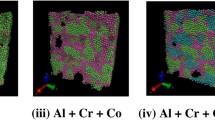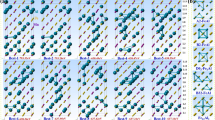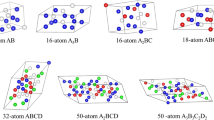Abstract
A set of embedded atom model (EAM) interatomic potentials was developed to represent highly idealized face-centered cubic (FCC) mixtures of Fe–Ni–Cr–Co–Al at near-equiatomic compositions. Potential functions for the transition metals and their crossed interactions are taken from our previous work for Fe–Ni–Cr–Co–Cu [D. Farkas and A. Caro: J. Mater. Res. 33 (19), 3218–3225, 2018], while cross-pair interactions involving Al were developed using a mix of the component pair functions fitted to known intermetallic properties. The resulting heats of mixing of all binary equiatomic random FCC mixtures not containing Al is low, but significant short-range ordering appears in those containing Al, driven by a large atomic size difference. The potentials are utilized to predict the relative stability of FCC quinary mixtures, as well as ordered L12 and B2 phases as a function of Al content. These predictions are in qualitative agreement with experiments. This interatomic potential set is developed to resemble but not model precisely the properties of this complex system, aiming at providing a tool to explore the consequences of the addition of a large size-misfit component into a high entropy mixture that develops multiphase microstructures.
Access this article
We’re sorry, something doesn't seem to be working properly.
Please try refreshing the page. If that doesn't work, please contact support so we can address the problem.










Similar content being viewed by others
References
B.S. Murty, J.W. Yeh, and S. Ranganathan: High-entropy alloys. In High-Entropy Alloys (Butterworth-Heinemann, 2014); p. 1. ISBN: 9780128002513.
Y. Zhang, T.T. Zuo, Z. Tang, M.C. Gao, K.A. Dahmen, P.K. Liaw, and Z.P. Lu: Microstructures and properties of high-entropy alloys. Prog. Mater. Sci. 61, 1 (2014).
D.B. Miracle and O.N. Senkov: A critical review of high entropy alloys and related concepts. Acta Mater. 122, 448 (2017).
B.E. Macdonald, Z. Fu, B. Zheng, W. Chen, Y. Lin, F. Chen, L. Zhang, J. Ivanisenko, Y. Zhou, H. Hahn, and E.J. Lavernia: Recent progress in high entropy alloy research. JOM 69, 2024 (2017).
B. Cantor, I.T.H. Chang, P. Knight, and A.J.B. Vincent: Microstructural development in equiatomic multicomponent alloys. Mater. Sci. Eng. A 375, 213 (2004).
F. Otto, Y. Yang, H. Bei, and E.P. George: Relative effects of enthalpy and entropy on the phase stability of equiatomic high-entropy alloys. Acta Mater. 61, 2628 (2013).
J.W. Yeh, S.K. Chen, S.J. Lin, J.Y. Gan, T.S. Chin, T.T. Shun, C.H. Tsau, and S.Y. Chang: Nanostructured high-entropy alloys with multiple principal elements: Novel alloy design concepts and outcomes. Adv. Eng. Mater. 6, 299 (2004).
Z. Tang, M.C. Gao, H. Diao, T. Yang, J. Liu, T. Zuo, Y. Zhang, Z. Lu, Y. Cheng, Y. Zhang, K.A. Dahmen, P.K. Liaw, and T. Egami: Aluminum alloying effects on lattice types, microstructures, and mechanical behavior of high-entropy alloy systems. JOM 65, 1848–1858 (2013).
A. Manzoni, H. Daoud, R. Völkl, U. Glatzel, and N. Wanderka: Phase separation in equiatomic AlCoCrFeNi high-entropy alloy. Ultramicroscopy 132, 212–215 (2013).
W.R. Wang, W.L. Wang, S.C. Wang, Y.C. Tsai, C.H. Lai, and J.W. Yeh: Effects of Al addition on the microstructure and mechanical property of AlxCoCrFeNi high-entropy alloys. Intermetallics 26, 51 (2012).
W.H. Liu, Y. Wu, J.Y. He, T.G. Nieh, and Z.P. Lu: Grain growth and the Hall-Petch relationship in a high-entropy FeCrNiCoMn alloy. Scr. Mater. 68, 526 (2013).
A.J. Zaddach, C. Niu, C.C. Koch, and D.L. Irving: Mechanical properties and stacking fault energies of NiFeCrCoMn high-entropy alloy. J. Mater. 65, 1780 (2013).
B. Gludovatz, A. Hohenwarter, D. Catoor, E.H. Chang, E.P. George, and R.O. Ritchie: A fracture-resistant high-entropy alloy for cryogenic applications. Science 345, 1153 (2014).
Y. Zhang, G. Malcolm Stocks, K. Jin, C. Lu, H. Bei, B.C. Sales, L. Wang, L.K. Béland, R.E. Stoller, G.D. Samolyuk, M. Caro, A. Caro, and W.J. Weber: Influence of chemical disorder on energy dissipation and defect evolution in concentrated solid solution alloys. Nat. Commun. 6, 8736 (2015). doi: 10.1038/ncomms9736.
Y. Zhang, Z.P. Lu, S.G. Ma, P.K. Liaw, Z. Tang, Y.Q. Cheng, and M.C. Gao: Guidelines in predicting phase formation of high-entropy alloys. MRS Commun. 4, 57 (2014).
A-C. Yeh, Y-J. Chang, C-W. Tsai, Y-C. Wang, J-W. Yeh, and C-M. Kuo: On the solidification and phase stability of a Co-Cr-Fe-Ni-Ti high-entropy alloy. Metall. Mater. Trans. A 45, 184 (2014).
Y. Dong, Y.P. Lu, L. Jiang, T.M. Wang, and T.J. Li: Effects of electro-negativity on the stability of topologically close-packed phase in high entropy alloys. Intermetallics 52, 105 (2014).
M.C. Gao and D.E. Alman: Searching for next single-phase high-entropy alloy compositions. Entropy 15, 4504 (2013).
A.K. Singh, N. Kumar, A. Dwivedi, and A. Subramaniam: A geometrical parameter for the formation of disordered solid solutions in multi-component alloys. Intermetallics 53, 112 (2014).
M.G. Poletti, and L. Battezzati: Electronic and thermodynamic criteria for the occurrence of high entropy alloys in metallic systems. Acta Mater. 75, 297 (2014).
P. Wang, Y. Wu, J.B. Liu, and H.T. Wang: Impacts of atomic scale lattice distortion on dislocation activity in high-entropy alloys. Extreme Mech. Lett. 17, 38 (2017).
H.Q. Song, F.Y. Tian, Q.M. Hu, L. Vitos, Y.D. Wang, J. Shen, and N.X. Chen: Local lattice distortion in high-entropy alloys. Phys. Rev. Mater. 1, 02340423 (2017).
H.S. Oh, D. Ma, G.P. Leyson, B. Grabowski, E.S. Park, F. Kormann, and D. Raabe: Lattice distortions in the FeCoNiCrMn high entropy alloy studied by theory and experiment. Entropy 18, 321 (2016).
T.M. Pollock and R. LeSar: The feedback loop between theory, simulation and experiment for plasticity and property modeling. Curr. Opin. Solid State Mater. Sci. 17, 10 (2013).
S.J. Zhao, W.J. Weber, and Y.W. Zhang: Unique challenges for modeling defect dynamics in concentrated solid-solution alloys. JOM 69, 2084 (2017).
I. Toda-Caraballo, J.S. Wrobel, D. Nguyen-Manh, P. Perez, and P.E.J. Rivera-Diaz-Del-Castillo: Simulation and modeling in high entropy alloys. JOM 69, 2137 (2017).
H. Van Swygenhoven, M. Spaczer, A. Caro, and D. Farkas: Competing plastic deformation mechanisms in nanophase metals. Phys. Rev. B 60, 22 (1999).
C. Vailhe and D. Farkas: Transition from dislocation core spreading to dislocation dissociation in a series of B2 compounds. Philos. Mag. A 79, 921 (1999).
C. Vailhe and D. Farkas: Interatomic potentials and dislocation simulation for the ternary B2 Ni-35Al-12Fe alloy. Mater. Sci. Eng. A 258, 26 (1998).
D. Farkas and A. Caro: Model interatomic potentials and lattice strain in high entropy alloys. J. Mater. Res. 33, 3218–3225 (2018).
C. Kittel: Introduction to Solid State Physics (Wiley-Interscience, New York, 1986).
R.C. Weast, ed.: Handbook of Chemistry and Physics (CRC, Boca Raton, FL, 1984).
G. Simons and H. Wang: Single Crystal Elastic Constants and Calculated Aggregate Properties (MIT Press, Cambridge, MA, 1977).
Y. Mishin, D. Farkas, M.J. Mehl, and D.A. Papaconstantopoulos: Interatomic potentials for monoatomic metals from experimental data and ab initio calculations. Phys. Rev. B 59, 3393 (1999).
H.E. Schaefer, R. Gugelmeier, M. Schmolz, and A. Seeger: Positron lifetime spectroscopy and trapping at vacancies in aluminium. Mater. Sci. Forum 15–18, 111–116 (1987).
L.E. Murr: Interfacial Phenomena in Metals and Alloys (Addison-Wesley, Reading, MA, 1975).
S.B. Sinnott, M.S. Stave, T.J. Raeker, and A.E. DePristo: Corrected effective-medium study of metal-surface relaxation. Phys. Rev. B 44, 8927 (1991).
M.J. Mehl and D.A. Papaconstantopoulos: Applications of a tight-binding total-energy method for transition and noble metals: Elastic constants, vacancies, and surfaces of monatomic metals. Phys. Rev. B 54, 4519 (1996).
R. Lizárraga, F. Pan, L. Bergqvist, E. Holmström, Z. Gercsi, and L. Vitos: First principles theory of the hcp-fcc phase transition in cobalt. Sci. Rep. 7, 3778 (2017).
R. Soulairol, C.-C. Fu, and C. Barreteau: Structure and magnetism of bulk Fe and Cr: From plane waves to LCAO methods. J. Phys.: Condens. Matter 22, 295502 (2010).
Y. Mishin: Atomistic modeling of the γ and γ'-phases of the Ni-Al system. Acta Mater. 52, 1451–1467 (2004). doi:10.1016/j.actamat.2003.11.026.
Y. Mishin, M.J. Mehl, and D.A. Papaconstantopoulos: Embedded-atom potential for B2-NiAl. Phys. Rev. B 65, 224114 (2002).
C. Vailhé and D. Farkas: Shear faults and dislocation core structures in B2 CoAl. J. Mater. Res. 12, 2559–2570 (1997).
C. Vailhe and D. Farkas: Shear faults and dislocation core structure simulations in B2 FeAl. Acta Mater. 45 4463–4473 (1997).
G.P. Purja Pun, V. Yamakov, and Y. Mishin: Interatomic potential for the ternary Ni–Al–Co system and application to atomistic modeling of the B2–L10 martensitic transformation. Model. Simul. Mat. Sci. Eng. 23, 065006 (2015).
M.I. Mendelev, D.J. Srolovitz, G.J. Ackland, and S. Han: Effect of Fe segregation on the migration of a mon-Symmetric Σ5 Tilt grain boundary in Al. J. Mater. Res. 20, 208–218 (2005).
A. Taylor and N.J. Doyle: Further studies on the nickel-aluminium system. I. [beta]-NiAl and [delta]-Ni2Al3 phase fields. J. Appl. Cryst. 5, 201–209 (1972).
S.A. Makhlouf, T. Nakamura, and M. Shiga: Structure and magnetic properties of FeAl1− xRhx alloys. J. Magn. Magn. Mater. 135, 257 (1994).
P. Villars and L.D. Calvert: Person's Handbook of Crystallographic Data for Intermetallic Phases 1-3, ASM Internat (Metals Park, Ohio, 1985).
S. Plimpton: Fast parallel algorithms for short-range molecular-dynamics. J. Comput. Phys. 117, 1 (1995).
A. Stukowski: Visualization and analysis of atomistic simulation data with OVITO-the Open Visualization Tool. Model. Simul. Mat. Sci. Eng. 18, 015012 (2010).
Z. Tang, C.G.A.O. Michael, H. Diao, T. Yang, J. Liu, T. Zuo, Y. Zhang, Z. Lu, Y. Cheng, Y. Zhang, K.A. Dahmen, P.K. Liaw, and T. Egami: Aluminum alloying effects on lattice types, microstructures, and mechanical behavior of high-entropy alloys systems. JOM 65, 1848–1858 (2013).
X. Sun, H. Zhang, W. Li, X. Ding, Y. Wang, and L. Vitos: Generalized stacking fault energy of Al-doped CrMnFeCoNi high-entropy alloy. Nanomaterials 10, 59 (2020). doi:10.3390/nano10010059.
L.J. Santodonato, P.K. Liaw, R.R. Unocic, H. Bei, and J.R. Morris: Predictive multiphase evolution in Al-containing high-entropy alloys. Nat. Commun. 9, 4520 (2018).
S. Shafeie, S. Guo, Q. Hu, H. Fahlquist, P. Erhart, and A. Palmqvist: High-entropy alloys as high-temperature thermoelectric materials. J. Appl. Phys. 118, 184905 (2015).
S. Shafeie, S. Guo, P. Erhart, Q. Hu, and A. Palmqvist: Balancing scattering channels. A panoscopic approach towards zero temperature coefficient of resistance using high entropy alloys. Adv. Mater. 31, 1805392 (2019).
T. Yang, S. Xia, S. Liu, C. Wang, S. Liu, Y. Zhang, J. Xue, S. Yan, and Y. Wang: Effects of Al addition on microstructure and mechanical properties of AlxCoCrFeNi high-entropy alloy. Mater. Sci. Eng. A 648, 15 (2015).
W.R. Wang, W.L. Wang, and J.W. Yeh: Phases, microstructure and mechanical properties of AlxCoCrFeNi high-entropy alloys at elevated temperatures. J. Alloys Compd. 589, 143 (2014).
D. Farkas, B. Mutasa, C. Vailhe, and K. Ternes: Interatomic potentials for B2 NiAl and martensitic phases. Model. Simul. Mat. Sci. Eng. 3, 201 (1995).
D. Farkas and C. Jones: Interatomic potentials for ternary Nb-Ti-Al alloys. Model. Simul. Mat. Sci. Eng. 4, 23 (1996).
D. Farkas, D. Roqueta, A. Vilette, and K. Ternes: Atomistic simulations in ternary Ni-Ti-Al alloys. Model. Simul. Mat. Sci. Eng. 4, 359 (1996).
D. Farkas, C.G. Schon, M.S.F. DeLima, and H. Goldenstein: Embedded atom computer simulation of lattice distortion and dislocation core structure and mobility in Fe-Cr alloys. Acta Mater. 44, 409 (1996).
Acknowledgment
This work was supported by the National Science Foundation, Division of Materials Research, under Grant No. 1507846.
Author information
Authors and Affiliations
Corresponding author
Rights and permissions
About this article
Cite this article
Farkas, D., Caro, A. Model interatomic potentials for Fe–Ni–Cr–Co–Al high-entropy alloys. Journal of Materials Research 35, 3031–3040 (2020). https://doi.org/10.1557/jmr.2020.294
Received:
Accepted:
Published:
Issue Date:
DOI: https://doi.org/10.1557/jmr.2020.294




